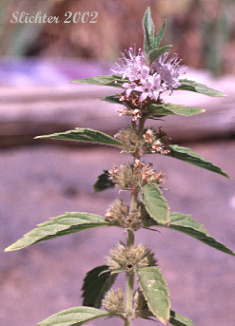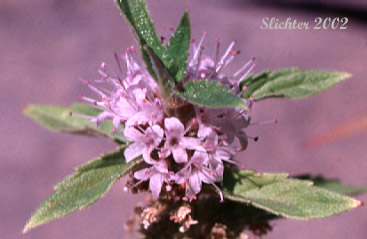 Characteristics:
Characteristics:
Field mint is a perennial with creeping rhizomes. The several to numerous stems ascend from 20-80 cm in height. The herbage is pubescent with a few to many short to longer, spreading hairs. The leaves are opposite on the stems, and are a pale to bright green in color. They may be glabrous or pubescent. The leaves have short petioles, with blades from 2-8 cm long and 6-40 mm wide. They are narrowly ovate, elliptic-ovate, or rhombic-elliptic in shape. The leaf margins are toothed.
The inflorescence consists of numerous, dense whorls of pale pink flowers which are often nearly hidden by the leaves. The whorls are found in the leaf axils. The calyx is pubescent, ranging in length from 2.5-3 mm long. The corolla is tubular, ranging form 4-7 mm in length. The corollas are white, pink or light purple.
The leaves of field mint are edible and like the leaves of peppermint, may be eaten raw or dried for use as a tea. The active ingredient in field mint is menthol which allows the plant to be used like other mints as a remedy for upset stomachs.
Habitat:
Field mint may be found in moist places along streams and shores of larger rivers from the lowlands to medium altitudes in the mountains.
Range:
Field mint is a circumboreal plant, which in North America, may be found from the Arctic south to California, New Mexico, Missouri, and Virginia.
